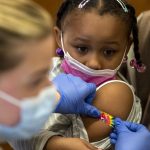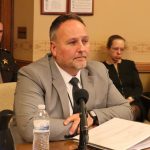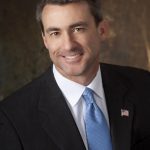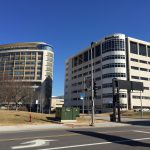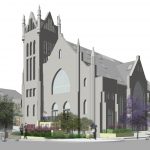School Districts Battle Over In-Person Classes
Parents push for this as health officials, teachers say state’s spiking pandemic makes this unsafe.
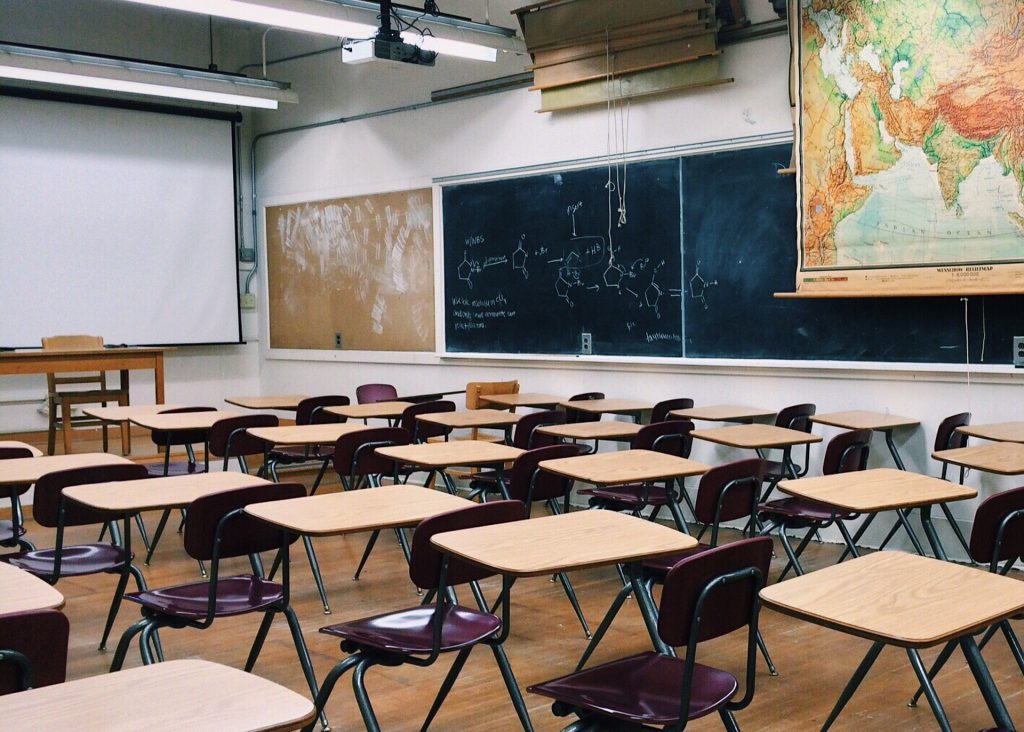
School classroom. Image by Wokandapix on Pixabay
Update: On Monday Oconto Falls School District announced classes will be virtual until Nov. 1 for grades 2-12. So far, 30 staff members are out because they are positive or quarantined and 8% of the student body is out due to positive tests or quarantine.
“When is this going to end? When will we just say, ‘Enough! We have to figure out how to get these kids back in school.’” So stated one parent before the Oak Creek-Franklin Board of Education at a special meeting on September 8.
Other parents listed the failings of the virtual education being offered to their children. No one spoke in favor of maintaining the virtual education program.
The board decided to begin opening on September 28, not so much because they had met the benchmarks for opening that they had established a month ago, but, rather, because they simply had decided to change the standards. Parents wanted their kids back in school.
When the school board first decided to go virtual back in August, the positivity rate was 9.6%, that is, the percentage of people who tested positive for COVID-19 out of all those who were tested over a two-week period. Johns Hopkins University and the World Health Organization recommended that schools should not be opened for in-person instruction if the positivity rate was above 5%.
The Oak Creek health commissioner, Darcy DuBois, explained to the school board on September 8 that the health commissioners in Milwaukee County had collectively decided to modify that recommendation to allow in-person instruction if the infection rate was between 5% and 10% and dropping. When the school board met that night, the infection rate in Oak Creek had dropped to 6.5%.
School board members clearly felt that the infection rate was within the new guidelines and parents were clamoring for schools to open.
Two board members, Darin Grabowski and Frank Carini, pushed hard for an opening. “I want the doors opened,” stated Cain. He conceded that there might be “jumps” up and down in the infection rate, but education needed to move forward.
The board voted not to hold exactly to the infection rate as a required standard, but instead to use the rate as “persuasive data” to help determine whether to keep the schools open.
The board decided to move to a stage-two opening where elementary students would utilize social distancing and secondary students would be broken into two groups, each group attending in-person classes two days a week beginning September 28.
On the very day the school board decided to open, September 8, the two-week infection rate in Oak Creek jumped to 9.8%; on September 15 it jumped again to 10.1%. But because the board was now only treating the infection rate as one consideration among many, it had no obligation to close the schools down.
Fortunately, on September 22, the infection rate once again dropped to 8.7%, just days before the reopening of in-person instruction.
To put this in perspective, New York City began opening its elementary schools this fall, much to the dismay of many of its citizens. The seven-day infection rate in New York at the time was 1.38%. It has since begun to rise and the city is closing schools in hard-hit areas including Brooklyn and Queens, where positivity rates are between 3% and 8%.
The infection rate in Oak Creek has never strayed far from the mark set in August when the board decided to go to virtual instruction. Instead, it followed the lead of the parent who spoke at the meeting – “Enough!”
Will the teachers show up?
In August, the Examiner raised the question whether teachers would show up for classes if they felt the virus was out of control in their school districts. A larger number of teachers in Kenosha answered that question: “No.”
Unlike Oak Creek Franklin which could only point to infection rates in the general community, Kenosha had real school infection numbers. On September 21, the district announced that a handful of students were now testing positive for COVID-19. Class-wide quarantines were being implemented. The following day, 276 teachers, roughly a third of the district’s teachers, called in sick, shutting down seven schools.
Some media outlets stated that the teachers’ union, the Kenosha Education Association (KEA) would not answer whether they instigated or coordinated a teacher sickout. KEA Executive Director Kendra Koeppen-Mulwana more or less sidestepped the question of the KEA’s role in answer to questions from the Examiner. But as teachers become increasingly worried about their health and the lack of comprehensive school safety measures, it’s not hard to imagine a wildcat sickout protest, which could be sparked by individual teachers and spread like a California wildfire.
After the police shooting of Jacob Blake in Kenosha and the protests and violence that followed, the Kenosha teachers’ sickout looked more like a minor brush fire.
There was already a lot of mistrust between teachers and the school board.
Mulwana stated that the Kenosha school board voted to go virtual in the fall on July 28. Then it “unexpectedly voted to switch to a hybrid model on August 18 and delayed the start of the school year to September 14; the whiplash was anxiety-inducing for many educators who now only had a few weeks to rethink their whole approach to the school year.”
When the school board met concerning school closings on September 22, a high school student ambassador took the teachers to task who called in sick: “Giving the good teachers that showed up a bad name” and calling teachers who didn’t show up for work “bullies.”
A parent stated: “Teachers have broken trust… How are students going to trust them again?” Parents were worried that their children would fail or at least fall behind if classes didn’t get back to normal.
But unlike what happened in Oak Creek Franklin, Kenosha teachers showed up. Teacher David Underwood saw that students were not socially distancing in school; masks were loose, below the nose. They were not complying, and nothing was being done.
Said one teacher, “I have a colleague whose father died of it; a colleague whose son was on a ventilator. I have a student who lost someone within his family.” A couple of teachers stated what they thought was inevitable: We are all going to be virtual.
Most of the teachers went back to school. Three schools remained virtual.
The virtual alternative
Kenosha is the largest Wisconsin district to begin the school year with in-person classes. For other large Wisconsin districts like Milwaukee, virtual was the logical option.
Milwaukee Superintendent Keith P. Posley was clearly optimistic when he spoke to the school board on September 24. “We were in a festive mood, with everyone excited to start the school year. Virtual education is going very well, and we have received a great deal of positive feedback.”
School board members jumped on board stating that they, too, had received positive feedback from teachers and parents alike. “One of the principals was excited in how engaged the students were in virtual learning,” said school board director Marva Herndon.
However, the Milwaukee school board takes testimony from citizens only at committee meetings, not at the full board level. No one could show up at the meeting with a protest sign because all meetings are being held virtually.
The one dark cloud that presented itself in the superintendent’s sunny presentation was that over 3,000 students were missing from the enrollment projection of 75,800 students. Posley stated that his administration was contacting those families. Some students were simply sitting at home not connecting to their virtual classrooms for various reasons.
Some parents who worked had their children enrolled in daycare over the summer. When the school year started, these parents could not leave their young children home alone, so they kept them in daycare. Posley conceded that some parents may have found other schools with in-person education.
But the missing students were also a concern of board members because of their impact on the finances of the district. State funding is partly based upon a count of student enrollment on the third Friday in September. Over 3,000 missing children could have a major impact on district funds.
Executive director of the Wisconsin Association of School Boards, John Ashley, told the board during its online meeting that the financial hardships facing Milwaukee Public Schools were also being felt by districts around the state. However, he saw no movement on the part of the state Legislature to address the problem at this time.
The third Friday count will be examined by school districts from around the state and sent to the Department of Public Instruction. Actual statewide numbers will not be available until sometime later in October. What enrollment numbers will look like at that time is hard to determine.
‘Cases spiking – parents want their kids out.’
Oconto Falls school district is just 30 miles northwest of Green Bay. The school system’s latest report shows that 14 staff and students have been infected over the last two weeks, with 134 students quarantined — 8% of the student body; the numbers appear to be rising. The school system continues with in-person education four days a week with Wednesday reserved for virtual education and deep cleaning.
“Now that cases are spiking, parents want their kids out,” says Oconto Falls teacher, Val Nickels. Students can plug into an online program called Acellus at the beginning of next semester. In the meantime, some students are attending their regular classes through a computer link using Zoom.
Nickels says that the school system will not go virtual unless 5% of the student body becomes infected with the virus. At one school alone, Oconto Falls Elementary, six teachers are out quarantined. They are still expected to teach their classes virtually with the students in the classrooms monitored by paraprofessionals.
Wisconsin has one of the highest virus infection rates in the country; the latest positive test count is 20%. The highest rate is in northeast Wisconsin. Oconto county has the fourth highest seven-day rate for Wisconsin.
Menomonee Falls schools announced on Friday, October 2, that the school system will not open for full in-person classes on Monday due to a spike in COVID-19 cases.
In West Allis, at the state fairgrounds, the Exhibition Hall remains set up to operate as an overflow site if the pandemic overwhelms local hospitals. Green Bay hospitals are near capacity. But, while the infection rate continues to rise, the death rate has not risen as fast. In many Wisconsin school districts, the public appears to be willing to accept increased infection rates so long as deaths do not increase. Whether public attitudes will change as cases surge, including at the White House, after President Trump’s COVID infection, remains to be seen. After the start of the school year, mitigation fatigue began to set in. Many parents complained that they were sick of wearing masks, social distancing, and keeping their kids out of school. They had had “enough.” But the pandemic is not over, and as fall turns to winter, there is no sign infection rates will let up.
Reprinted with permission of Wisconsin Examiner.



